Workplace Law: Employee Status, Contracts, and Dismissal Analysis
VerifiedAdded on 2023/04/25
|8
|1910
|456
Case Study
AI Summary
This case study delves into a workplace law scenario involving Bob, an employee at an RSL club. The analysis begins by examining whether Bob is an employee or a contractor, considering factors like control, exclusiveness of work, and payment methods. The study then assesses the enforceability of the employment contract, including the Code of Conduct, and its implications for Bob's conduct. Finally, the case evaluates the validity of Bob's dismissal, focusing on the allegations of inappropriate behavior and the club's policies. The document applies legal principles to determine Bob's employment status, contract obligations, and the justification for his termination, referencing relevant case law and legislation.
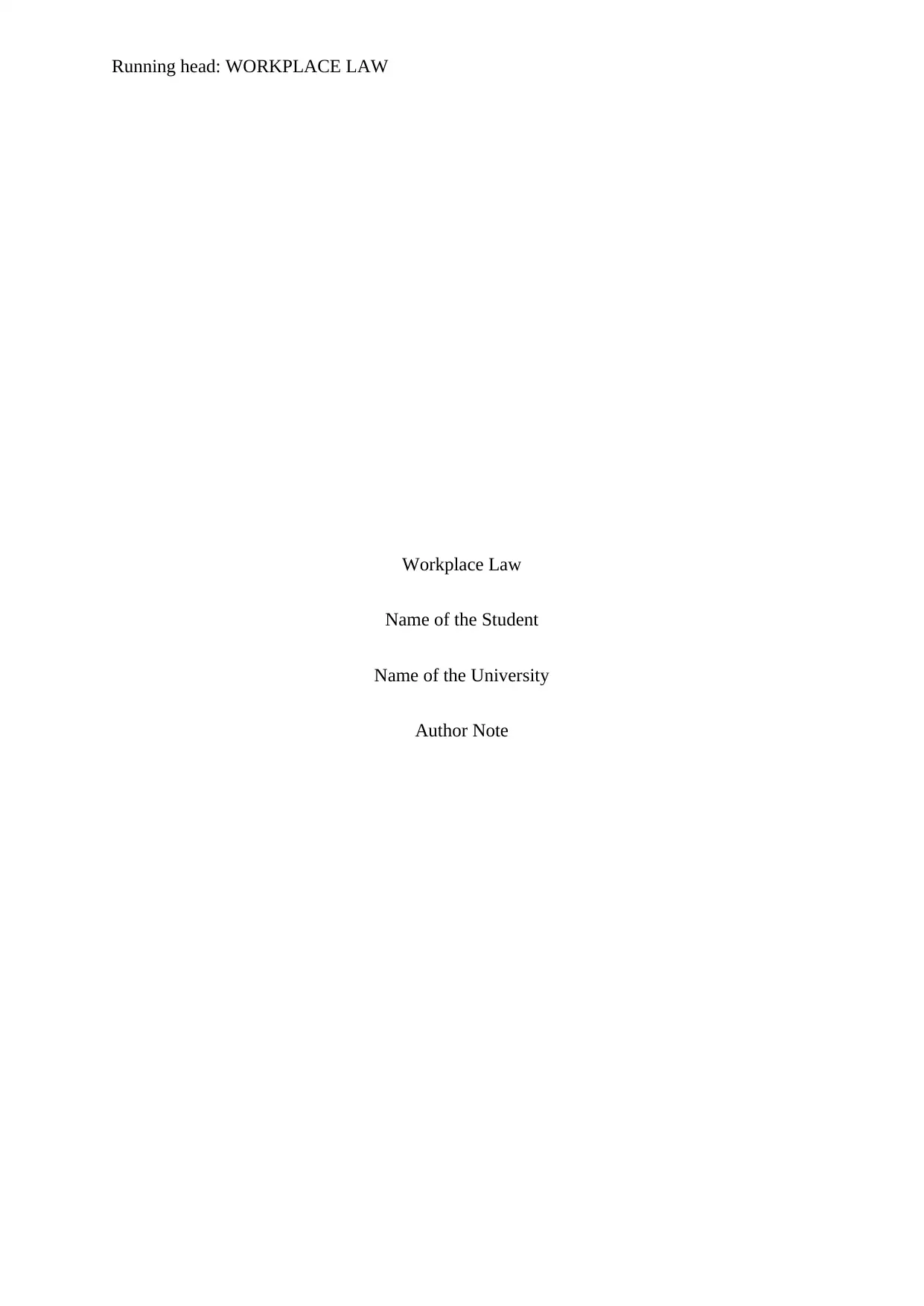
Running head: WORKPLACE LAW
Workplace Law
Name of the Student
Name of the University
Author Note
Workplace Law
Name of the Student
Name of the University
Author Note
Paraphrase This Document
Need a fresh take? Get an instant paraphrase of this document with our AI Paraphraser
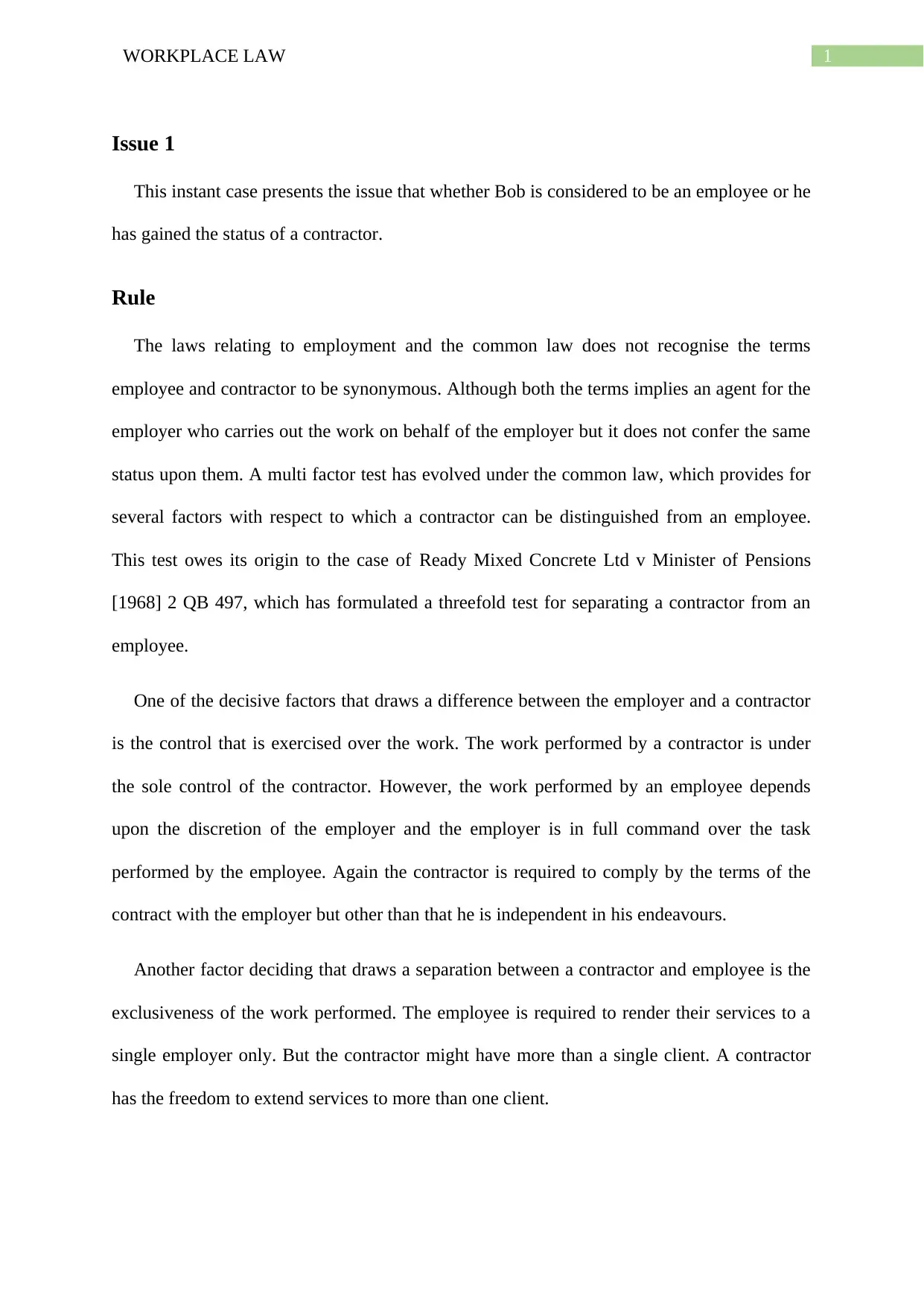
1WORKPLACE LAW
Issue 1
This instant case presents the issue that whether Bob is considered to be an employee or he
has gained the status of a contractor.
Rule
The laws relating to employment and the common law does not recognise the terms
employee and contractor to be synonymous. Although both the terms implies an agent for the
employer who carries out the work on behalf of the employer but it does not confer the same
status upon them. A multi factor test has evolved under the common law, which provides for
several factors with respect to which a contractor can be distinguished from an employee.
This test owes its origin to the case of Ready Mixed Concrete Ltd v Minister of Pensions
[1968] 2 QB 497, which has formulated a threefold test for separating a contractor from an
employee.
One of the decisive factors that draws a difference between the employer and a contractor
is the control that is exercised over the work. The work performed by a contractor is under
the sole control of the contractor. However, the work performed by an employee depends
upon the discretion of the employer and the employer is in full command over the task
performed by the employee. Again the contractor is required to comply by the terms of the
contract with the employer but other than that he is independent in his endeavours.
Another factor deciding that draws a separation between a contractor and employee is the
exclusiveness of the work performed. The employee is required to render their services to a
single employer only. But the contractor might have more than a single client. A contractor
has the freedom to extend services to more than one client.
Issue 1
This instant case presents the issue that whether Bob is considered to be an employee or he
has gained the status of a contractor.
Rule
The laws relating to employment and the common law does not recognise the terms
employee and contractor to be synonymous. Although both the terms implies an agent for the
employer who carries out the work on behalf of the employer but it does not confer the same
status upon them. A multi factor test has evolved under the common law, which provides for
several factors with respect to which a contractor can be distinguished from an employee.
This test owes its origin to the case of Ready Mixed Concrete Ltd v Minister of Pensions
[1968] 2 QB 497, which has formulated a threefold test for separating a contractor from an
employee.
One of the decisive factors that draws a difference between the employer and a contractor
is the control that is exercised over the work. The work performed by a contractor is under
the sole control of the contractor. However, the work performed by an employee depends
upon the discretion of the employer and the employer is in full command over the task
performed by the employee. Again the contractor is required to comply by the terms of the
contract with the employer but other than that he is independent in his endeavours.
Another factor deciding that draws a separation between a contractor and employee is the
exclusiveness of the work performed. The employee is required to render their services to a
single employer only. But the contractor might have more than a single client. A contractor
has the freedom to extend services to more than one client.
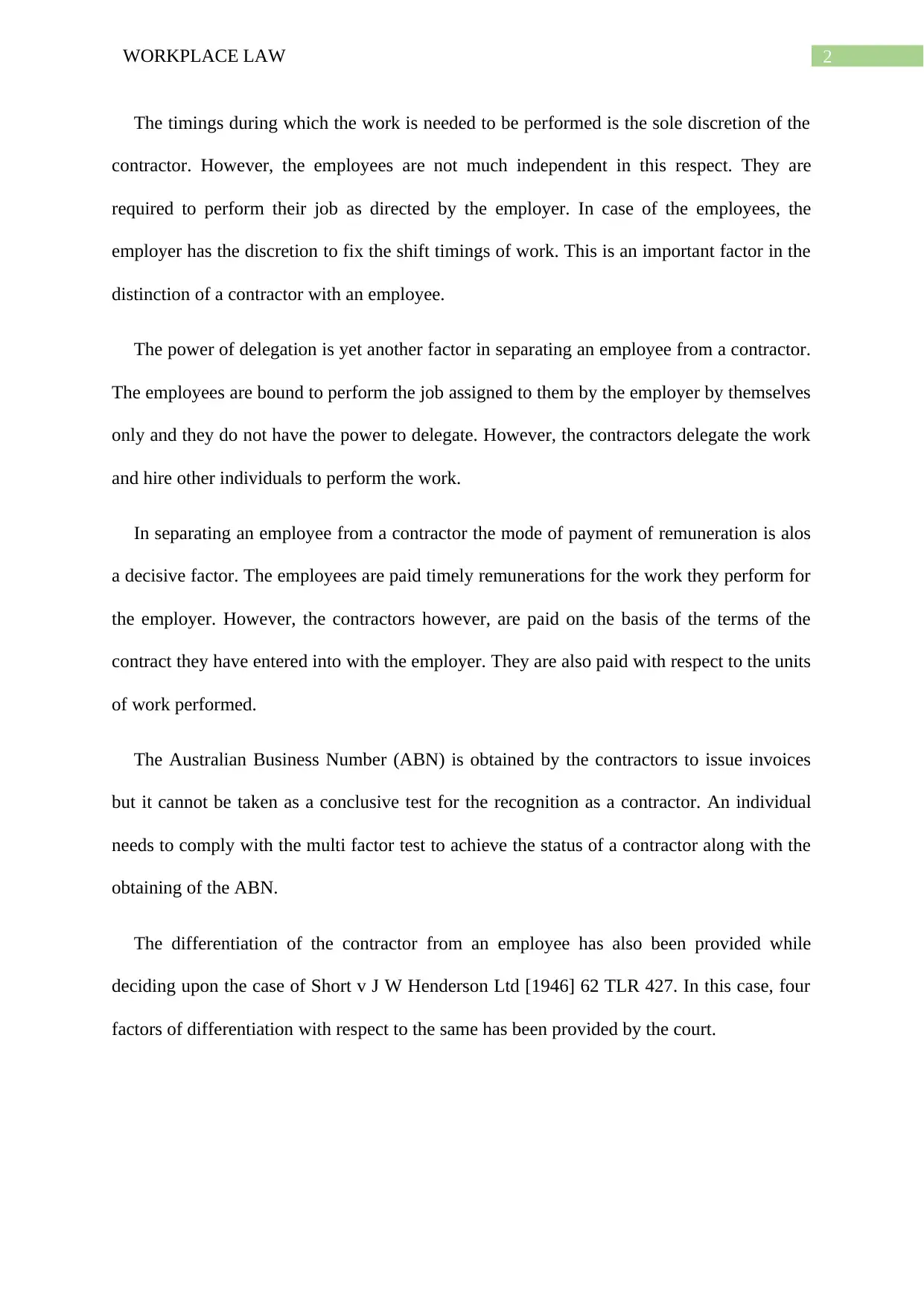
2WORKPLACE LAW
The timings during which the work is needed to be performed is the sole discretion of the
contractor. However, the employees are not much independent in this respect. They are
required to perform their job as directed by the employer. In case of the employees, the
employer has the discretion to fix the shift timings of work. This is an important factor in the
distinction of a contractor with an employee.
The power of delegation is yet another factor in separating an employee from a contractor.
The employees are bound to perform the job assigned to them by the employer by themselves
only and they do not have the power to delegate. However, the contractors delegate the work
and hire other individuals to perform the work.
In separating an employee from a contractor the mode of payment of remuneration is alos
a decisive factor. The employees are paid timely remunerations for the work they perform for
the employer. However, the contractors however, are paid on the basis of the terms of the
contract they have entered into with the employer. They are also paid with respect to the units
of work performed.
The Australian Business Number (ABN) is obtained by the contractors to issue invoices
but it cannot be taken as a conclusive test for the recognition as a contractor. An individual
needs to comply with the multi factor test to achieve the status of a contractor along with the
obtaining of the ABN.
The differentiation of the contractor from an employee has also been provided while
deciding upon the case of Short v J W Henderson Ltd [1946] 62 TLR 427. In this case, four
factors of differentiation with respect to the same has been provided by the court.
The timings during which the work is needed to be performed is the sole discretion of the
contractor. However, the employees are not much independent in this respect. They are
required to perform their job as directed by the employer. In case of the employees, the
employer has the discretion to fix the shift timings of work. This is an important factor in the
distinction of a contractor with an employee.
The power of delegation is yet another factor in separating an employee from a contractor.
The employees are bound to perform the job assigned to them by the employer by themselves
only and they do not have the power to delegate. However, the contractors delegate the work
and hire other individuals to perform the work.
In separating an employee from a contractor the mode of payment of remuneration is alos
a decisive factor. The employees are paid timely remunerations for the work they perform for
the employer. However, the contractors however, are paid on the basis of the terms of the
contract they have entered into with the employer. They are also paid with respect to the units
of work performed.
The Australian Business Number (ABN) is obtained by the contractors to issue invoices
but it cannot be taken as a conclusive test for the recognition as a contractor. An individual
needs to comply with the multi factor test to achieve the status of a contractor along with the
obtaining of the ABN.
The differentiation of the contractor from an employee has also been provided while
deciding upon the case of Short v J W Henderson Ltd [1946] 62 TLR 427. In this case, four
factors of differentiation with respect to the same has been provided by the court.
⊘ This is a preview!⊘
Do you want full access?
Subscribe today to unlock all pages.

Trusted by 1+ million students worldwide
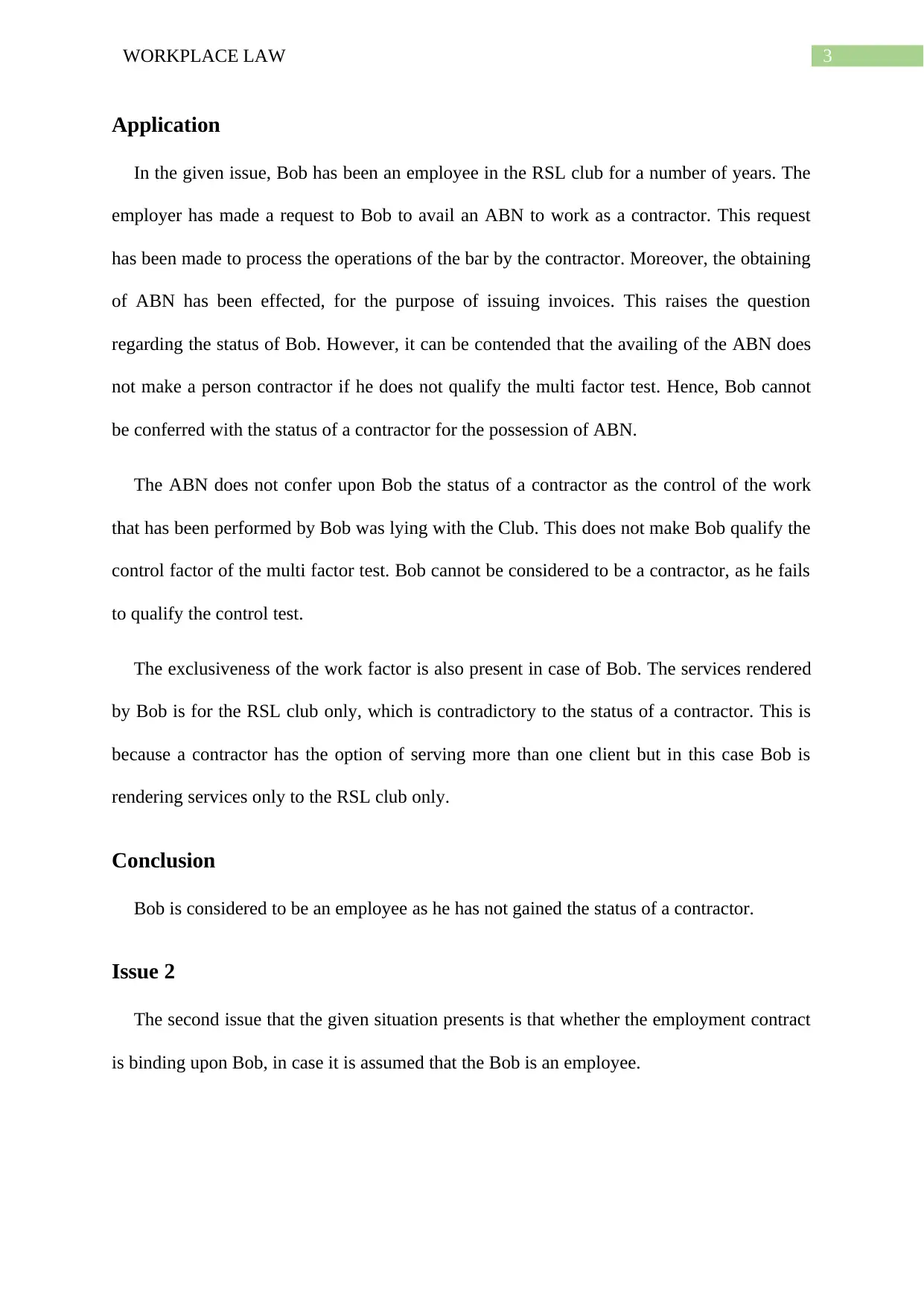
3WORKPLACE LAW
Application
In the given issue, Bob has been an employee in the RSL club for a number of years. The
employer has made a request to Bob to avail an ABN to work as a contractor. This request
has been made to process the operations of the bar by the contractor. Moreover, the obtaining
of ABN has been effected, for the purpose of issuing invoices. This raises the question
regarding the status of Bob. However, it can be contended that the availing of the ABN does
not make a person contractor if he does not qualify the multi factor test. Hence, Bob cannot
be conferred with the status of a contractor for the possession of ABN.
The ABN does not confer upon Bob the status of a contractor as the control of the work
that has been performed by Bob was lying with the Club. This does not make Bob qualify the
control factor of the multi factor test. Bob cannot be considered to be a contractor, as he fails
to qualify the control test.
The exclusiveness of the work factor is also present in case of Bob. The services rendered
by Bob is for the RSL club only, which is contradictory to the status of a contractor. This is
because a contractor has the option of serving more than one client but in this case Bob is
rendering services only to the RSL club only.
Conclusion
Bob is considered to be an employee as he has not gained the status of a contractor.
Issue 2
The second issue that the given situation presents is that whether the employment contract
is binding upon Bob, in case it is assumed that the Bob is an employee.
Application
In the given issue, Bob has been an employee in the RSL club for a number of years. The
employer has made a request to Bob to avail an ABN to work as a contractor. This request
has been made to process the operations of the bar by the contractor. Moreover, the obtaining
of ABN has been effected, for the purpose of issuing invoices. This raises the question
regarding the status of Bob. However, it can be contended that the availing of the ABN does
not make a person contractor if he does not qualify the multi factor test. Hence, Bob cannot
be conferred with the status of a contractor for the possession of ABN.
The ABN does not confer upon Bob the status of a contractor as the control of the work
that has been performed by Bob was lying with the Club. This does not make Bob qualify the
control factor of the multi factor test. Bob cannot be considered to be a contractor, as he fails
to qualify the control test.
The exclusiveness of the work factor is also present in case of Bob. The services rendered
by Bob is for the RSL club only, which is contradictory to the status of a contractor. This is
because a contractor has the option of serving more than one client but in this case Bob is
rendering services only to the RSL club only.
Conclusion
Bob is considered to be an employee as he has not gained the status of a contractor.
Issue 2
The second issue that the given situation presents is that whether the employment contract
is binding upon Bob, in case it is assumed that the Bob is an employee.
Paraphrase This Document
Need a fresh take? Get an instant paraphrase of this document with our AI Paraphraser
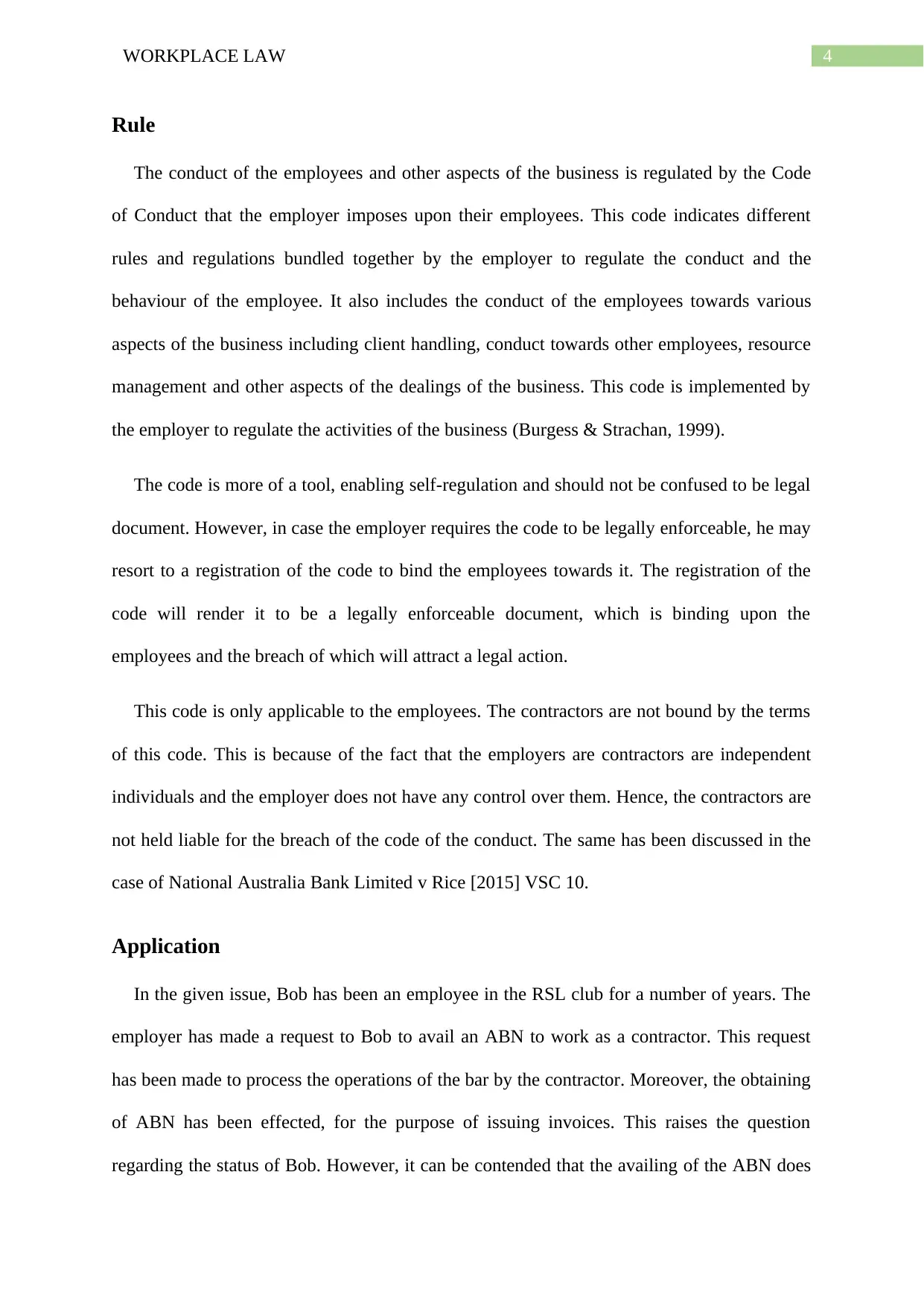
4WORKPLACE LAW
Rule
The conduct of the employees and other aspects of the business is regulated by the Code
of Conduct that the employer imposes upon their employees. This code indicates different
rules and regulations bundled together by the employer to regulate the conduct and the
behaviour of the employee. It also includes the conduct of the employees towards various
aspects of the business including client handling, conduct towards other employees, resource
management and other aspects of the dealings of the business. This code is implemented by
the employer to regulate the activities of the business (Burgess & Strachan, 1999).
The code is more of a tool, enabling self-regulation and should not be confused to be legal
document. However, in case the employer requires the code to be legally enforceable, he may
resort to a registration of the code to bind the employees towards it. The registration of the
code will render it to be a legally enforceable document, which is binding upon the
employees and the breach of which will attract a legal action.
This code is only applicable to the employees. The contractors are not bound by the terms
of this code. This is because of the fact that the employers are contractors are independent
individuals and the employer does not have any control over them. Hence, the contractors are
not held liable for the breach of the code of the conduct. The same has been discussed in the
case of National Australia Bank Limited v Rice [2015] VSC 10.
Application
In the given issue, Bob has been an employee in the RSL club for a number of years. The
employer has made a request to Bob to avail an ABN to work as a contractor. This request
has been made to process the operations of the bar by the contractor. Moreover, the obtaining
of ABN has been effected, for the purpose of issuing invoices. This raises the question
regarding the status of Bob. However, it can be contended that the availing of the ABN does
Rule
The conduct of the employees and other aspects of the business is regulated by the Code
of Conduct that the employer imposes upon their employees. This code indicates different
rules and regulations bundled together by the employer to regulate the conduct and the
behaviour of the employee. It also includes the conduct of the employees towards various
aspects of the business including client handling, conduct towards other employees, resource
management and other aspects of the dealings of the business. This code is implemented by
the employer to regulate the activities of the business (Burgess & Strachan, 1999).
The code is more of a tool, enabling self-regulation and should not be confused to be legal
document. However, in case the employer requires the code to be legally enforceable, he may
resort to a registration of the code to bind the employees towards it. The registration of the
code will render it to be a legally enforceable document, which is binding upon the
employees and the breach of which will attract a legal action.
This code is only applicable to the employees. The contractors are not bound by the terms
of this code. This is because of the fact that the employers are contractors are independent
individuals and the employer does not have any control over them. Hence, the contractors are
not held liable for the breach of the code of the conduct. The same has been discussed in the
case of National Australia Bank Limited v Rice [2015] VSC 10.
Application
In the given issue, Bob has been an employee in the RSL club for a number of years. The
employer has made a request to Bob to avail an ABN to work as a contractor. This request
has been made to process the operations of the bar by the contractor. Moreover, the obtaining
of ABN has been effected, for the purpose of issuing invoices. This raises the question
regarding the status of Bob. However, it can be contended that the availing of the ABN does
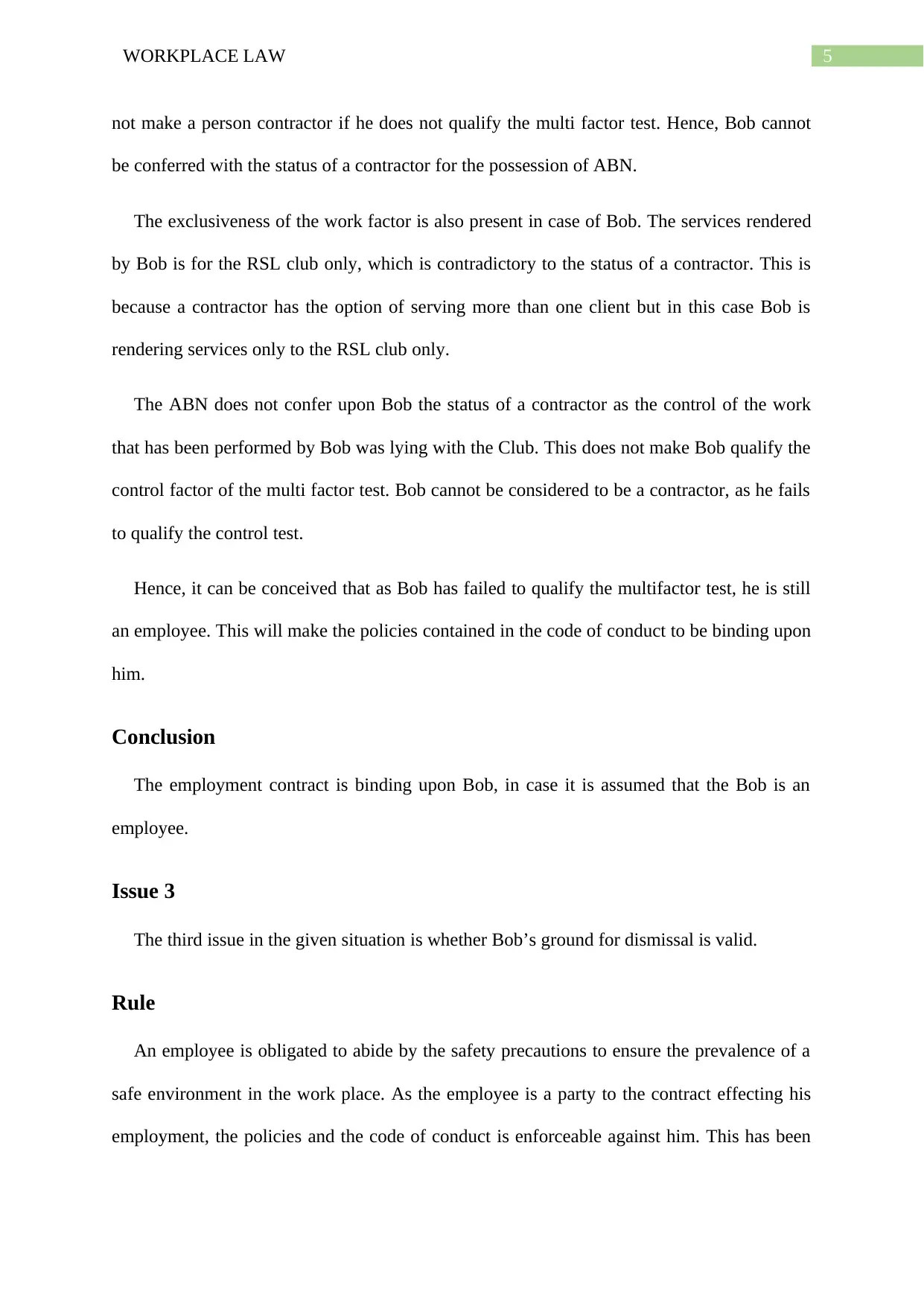
5WORKPLACE LAW
not make a person contractor if he does not qualify the multi factor test. Hence, Bob cannot
be conferred with the status of a contractor for the possession of ABN.
The exclusiveness of the work factor is also present in case of Bob. The services rendered
by Bob is for the RSL club only, which is contradictory to the status of a contractor. This is
because a contractor has the option of serving more than one client but in this case Bob is
rendering services only to the RSL club only.
The ABN does not confer upon Bob the status of a contractor as the control of the work
that has been performed by Bob was lying with the Club. This does not make Bob qualify the
control factor of the multi factor test. Bob cannot be considered to be a contractor, as he fails
to qualify the control test.
Hence, it can be conceived that as Bob has failed to qualify the multifactor test, he is still
an employee. This will make the policies contained in the code of conduct to be binding upon
him.
Conclusion
The employment contract is binding upon Bob, in case it is assumed that the Bob is an
employee.
Issue 3
The third issue in the given situation is whether Bob’s ground for dismissal is valid.
Rule
An employee is obligated to abide by the safety precautions to ensure the prevalence of a
safe environment in the work place. As the employee is a party to the contract effecting his
employment, the policies and the code of conduct is enforceable against him. This has been
not make a person contractor if he does not qualify the multi factor test. Hence, Bob cannot
be conferred with the status of a contractor for the possession of ABN.
The exclusiveness of the work factor is also present in case of Bob. The services rendered
by Bob is for the RSL club only, which is contradictory to the status of a contractor. This is
because a contractor has the option of serving more than one client but in this case Bob is
rendering services only to the RSL club only.
The ABN does not confer upon Bob the status of a contractor as the control of the work
that has been performed by Bob was lying with the Club. This does not make Bob qualify the
control factor of the multi factor test. Bob cannot be considered to be a contractor, as he fails
to qualify the control test.
Hence, it can be conceived that as Bob has failed to qualify the multifactor test, he is still
an employee. This will make the policies contained in the code of conduct to be binding upon
him.
Conclusion
The employment contract is binding upon Bob, in case it is assumed that the Bob is an
employee.
Issue 3
The third issue in the given situation is whether Bob’s ground for dismissal is valid.
Rule
An employee is obligated to abide by the safety precautions to ensure the prevalence of a
safe environment in the work place. As the employee is a party to the contract effecting his
employment, the policies and the code of conduct is enforceable against him. This has been
⊘ This is a preview!⊘
Do you want full access?
Subscribe today to unlock all pages.

Trusted by 1+ million students worldwide
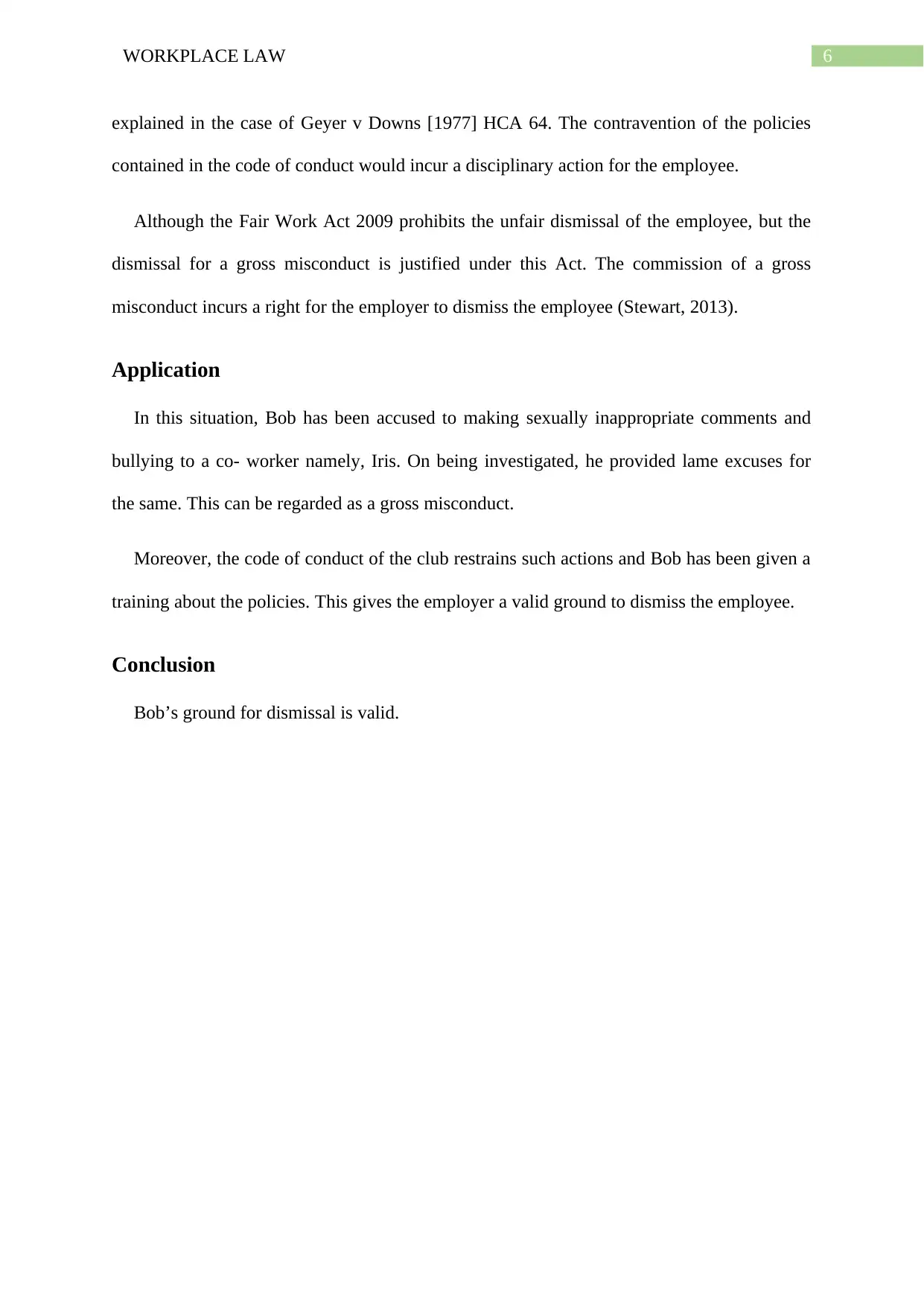
6WORKPLACE LAW
explained in the case of Geyer v Downs [1977] HCA 64. The contravention of the policies
contained in the code of conduct would incur a disciplinary action for the employee.
Although the Fair Work Act 2009 prohibits the unfair dismissal of the employee, but the
dismissal for a gross misconduct is justified under this Act. The commission of a gross
misconduct incurs a right for the employer to dismiss the employee (Stewart, 2013).
Application
In this situation, Bob has been accused to making sexually inappropriate comments and
bullying to a co- worker namely, Iris. On being investigated, he provided lame excuses for
the same. This can be regarded as a gross misconduct.
Moreover, the code of conduct of the club restrains such actions and Bob has been given a
training about the policies. This gives the employer a valid ground to dismiss the employee.
Conclusion
Bob’s ground for dismissal is valid.
explained in the case of Geyer v Downs [1977] HCA 64. The contravention of the policies
contained in the code of conduct would incur a disciplinary action for the employee.
Although the Fair Work Act 2009 prohibits the unfair dismissal of the employee, but the
dismissal for a gross misconduct is justified under this Act. The commission of a gross
misconduct incurs a right for the employer to dismiss the employee (Stewart, 2013).
Application
In this situation, Bob has been accused to making sexually inappropriate comments and
bullying to a co- worker namely, Iris. On being investigated, he provided lame excuses for
the same. This can be regarded as a gross misconduct.
Moreover, the code of conduct of the club restrains such actions and Bob has been given a
training about the policies. This gives the employer a valid ground to dismiss the employee.
Conclusion
Bob’s ground for dismissal is valid.
Paraphrase This Document
Need a fresh take? Get an instant paraphrase of this document with our AI Paraphraser
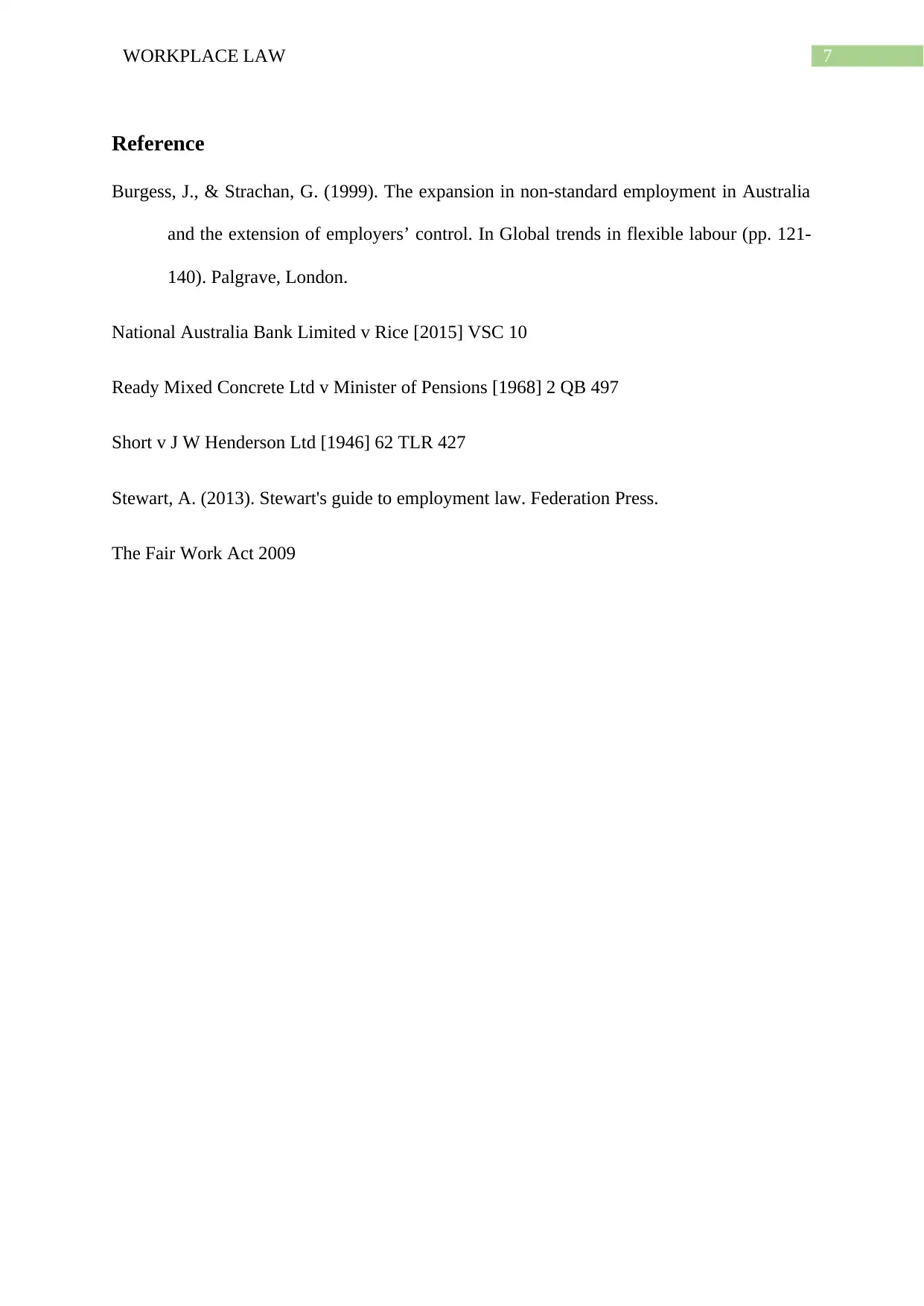
7WORKPLACE LAW
Reference
Burgess, J., & Strachan, G. (1999). The expansion in non-standard employment in Australia
and the extension of employers’ control. In Global trends in flexible labour (pp. 121-
140). Palgrave, London.
National Australia Bank Limited v Rice [2015] VSC 10
Ready Mixed Concrete Ltd v Minister of Pensions [1968] 2 QB 497
Short v J W Henderson Ltd [1946] 62 TLR 427
Stewart, A. (2013). Stewart's guide to employment law. Federation Press.
The Fair Work Act 2009
Reference
Burgess, J., & Strachan, G. (1999). The expansion in non-standard employment in Australia
and the extension of employers’ control. In Global trends in flexible labour (pp. 121-
140). Palgrave, London.
National Australia Bank Limited v Rice [2015] VSC 10
Ready Mixed Concrete Ltd v Minister of Pensions [1968] 2 QB 497
Short v J W Henderson Ltd [1946] 62 TLR 427
Stewart, A. (2013). Stewart's guide to employment law. Federation Press.
The Fair Work Act 2009
1 out of 8
Related Documents
Your All-in-One AI-Powered Toolkit for Academic Success.
+13062052269
info@desklib.com
Available 24*7 on WhatsApp / Email
![[object Object]](/_next/static/media/star-bottom.7253800d.svg)
Unlock your academic potential
Copyright © 2020–2025 A2Z Services. All Rights Reserved. Developed and managed by ZUCOL.





